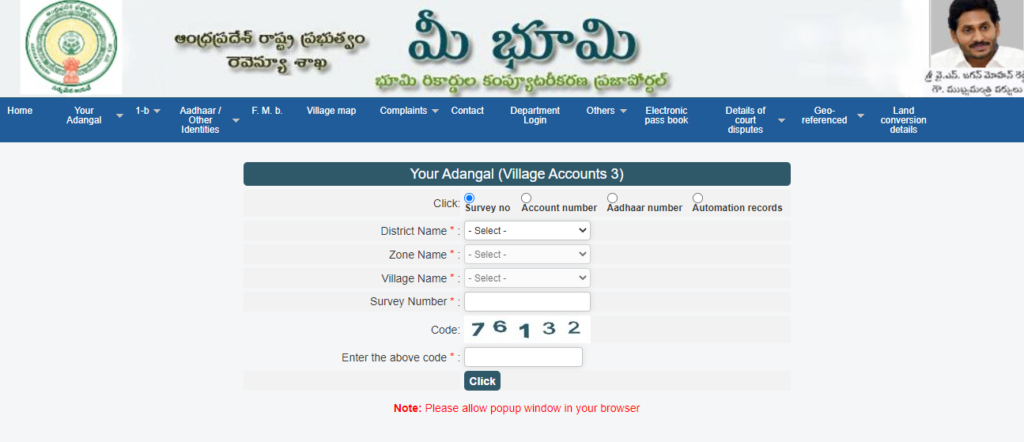In the vast tapestry of India’s land management system, there exists a term that echoes through centuries of tradition and bureaucracy, and that term is “Adangal.” It may not be a household name, but its importance in the domain of land records in India cannot be overstated
Maintaining documents in physical form requires proper maintenance and storage. To digitise all land records in Telangana, the government of Telangana has started an online portal called “Maa Bhoomi”.
Currently, the residents of Telangana can check all the online land record details from the official website Chief Commissioner of Land Administration (CCLA) and also through the Integrates Land Records Management System (ILRMS). The land and property owners in the state of Telangana can easily access the land records with the help of the website (online portal).
The data on the online portal comprises the extent of land, survey number, owner name attadar name, tax, nature of the land and crop and other relevant details. With the help of the “CCLA” portal, Pahani for all land situated in Telangana can also be downloaded.

Understanding Adangal
Adangal, also known as ‘Pahani’ or ‘Adhikara Niyamam,’ is essentially a land revenue record that documents vital information about a piece of land. This record serves as a legal document and is an integral part of land administration in India, particularly in rural areas. Its roots can be traced back to ancient times when agrarian societies needed a method to keep track of land holdings, crop cultivation, and revenue collection.
Pahani/Adangal
A Pahani or Adangal is a legal land related document issued by the Tahsildar. A Pahani or an Adangal contains details of the land. The contents of a Pahani/Adangal:
- Name of the Land Owner.
- Extents and Khata Number.
- Total Land under the Pahani.
- Details of the Land revenue.
- Land Cultivation resources.
- Hissa and Survey Number of the Land.
- Nature of procession of land.
- The process via which land is acquired by the owner.
- Soil Classification.
- The rights of the Government or Public rights on the Land.
- Liabilities of the Owners on the Land.
The Components of Adangal
Land Ownership Details: Adangal contains information about the landowner, including their name, title, and other relevant particulars. It is essential for establishing the legal ownership of the land.
Land Classification: It classifies the land into various categories, such as agricultural, non-agricultural, or barren, based on its current and historical use.
Crop Details: Adangal documents the crops cultivated on the land, enabling authorities to assess land revenue and taxation accordingly. This section also includes information about the crop season and expected yield.
Land Boundaries: Precise measurements and details of land boundaries help in avoiding disputes and encroachments.
Record of Rights: It enumerates the rights associated with the land, such as ownership, tenancy, or government-leased land.
Mutation Details: Any changes in landownership or land use are recorded in the mutation section, ensuring an up-to-date land register.
Checking Pahani or Adangal Online
Step 1: Log on to the “CCLA” website.
Step 2: On the homepage click on the “Know Your Land status” link.
Step 3: On this page, click on “Land Details Search” link given under the head “RECORD OF RIGHTS (ROR)” system. When clicked on “Land Details Search”, it will be redirected to the “Dharani Website” page.
Step 4: Enter credential Select district, division, mandal and village from the dropdown list. Now, search details by using three options- Khata No./Survey No., or Buyer Name/Seller Name or Mutation Date. After selecting the relevant no, click on the “Get Details” tab.
Step 5: Finally, Pahani details will appear on the screen. Candidates can check all the information available.
Step 6: Lastly, you can save the Pahani details and if you wish to take a printout of the same just click on the “Print Pahani Details” tab and retain it for further references.
FAQs
What is Pahani?
Pahani (also called “RTC” or Record of Rights, Tenancy, and Crops) is an important land document used in states like Karnataka, Telangana, and Andhra Pradesh. It contains detailed information about a piece of agricultural land, including the landowner’s details, type of soil, area, type of crop grown, water source, and liabilities, among other specifics.
What is Adangal?
Adangal (also known as “Village Account No. 2”) is a land record maintained by the Village Administrative Officer (VAO) or revenue department to document agricultural details of land in a particular village. It includes information about the crops grown, extent of land, ownership details, and other related data.